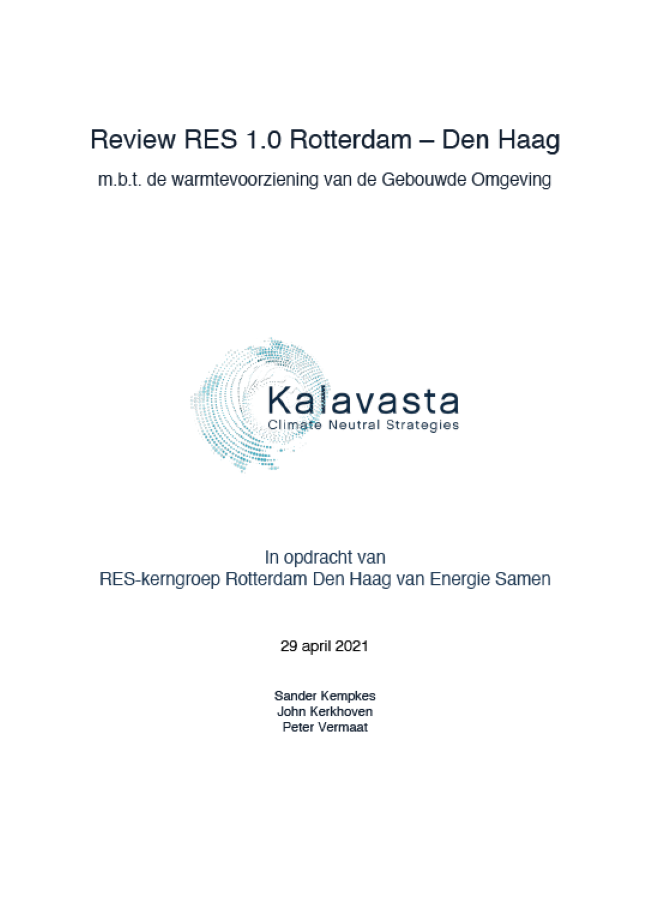Review RES 1.0 Rotterdam Den Haag (2021)
The RES-kerngroep Rotterdam Den Haag of Energie Samen asked Kalavasta to review the RES 1.0 region Rotterdam-The Hague on the topic of heat in the built environment.

What is a Regional Energy Strategy (RES) 1.0?
In the Dutch Climate Agreement from 2019, it is stated that the Netherlands will lower their emissions with 50% in 2030 and 95% in 2050 with respect to 1990. The Netherlands is divided in 30 energy regions that all write a Regional Energy Strategy (RES) in 2021 in which the national plans are translated to a regional level. In the RES, the region presents the plans to obtain its energy in the future and specifies projects such as where to build solar panels and wind turbines, and how to heat up/cool down the built environment in a energy neutral manner. The RES shows a possible route of a region, but in the end the decisions are made by the municipalities. The first version of the RES, the RES 1.0, has to be published on the 1st of July 2021, after which every two years there will be an updated version.
Why a review on the RES 1.0 Rotterdam-The Hague?
Nobody has ever performed an energy transition as the one we are facing now and no one has written a RES before. Therefore, it is useful to get feedback in an early stage of the process. Even though the energy transition will take place at the level of municipalities, the RES 1.0 has a large influence on how these municipalities will collaborate in order to reduce their emissions. In this light, we were asked by the RES-kerngroep Rotterdam Den Haag of Energie Samen to review the RES Rotterdam-The Hague, specifically on the subject of heat in the built environment. This subject is of particular importance in the Rotterdam-The Hague area since there is a high population density combined with potential collective heat systems such as the distribution of industrial waste heat or geothermal energy via district heating.
What did we do?
The review consists of two parts. In the first part, we scored the RES and the underlying eight reports on criteria that we derived from the goals of the RES 1.0. Examples of criteria are which heat solutions are discussed, what are the baseload options, and is the capacity of the heat sources comparable to the demand. The results are shown in table form where the criteria are scored in green (present), yellow (only mentioned in the text), and red (not mentioned) for all reports. In the second part, we answered seven questions posed by the RES-kerngroep that contained a variety of topics such as the risk of stranded assets in the RES 1.0, how local heat sources will compete with cheap industrial waste heat, and how the costs of the plans of the RES are divided.
All in all, the RES 1.0 is an informative report and describes how a collective heat system could be a good way to provide heating in the built environment. Together with the underlying reports, the RES 1.0 mentions a large number of topics that we expect in a strategic heat plan for the built environment. Nevertheless, a large number of topics is also not mentioned, with a particular lack of the individual route with e.g. a hybrid heat pump. Furthermore, even though the RES 1.0 should contain a strategy, we could not find any specific strategic plans of what, how, and when these plans can be realised at what costs. At the moment, we think it is not possible for municipalities to make decent decisions on the heat topics given the information that is in the RES 1.0. We strongly recommend the authors of RES 2.0 to formulate goals for 2030, to focus on sustainable heat solutions that can already be implemented tomorrow to lower the CO2 emissions as soon as possible, and to specify when certain parts of a collective heat system can be realised with a cost comparison to individual routes.
What's next?
The RES 1.0 is only the beginning and therefore should be considered as a first attempt to formulate a route to the climate goals of 2030 and 2050. In our review, we tried to focus on realising emission reduction as soon as possible (isolation and hybrid heat pumps), how to deal with fall-back options and adaptation, and the importance to look at the heat transition as an integral process (that includes cooling as well). This is the first review of a RES, and therefore we hope it serves as useful input for the RES 2.0, not only for the Rotterdam-The Hague area, but also for the other RES regions.
